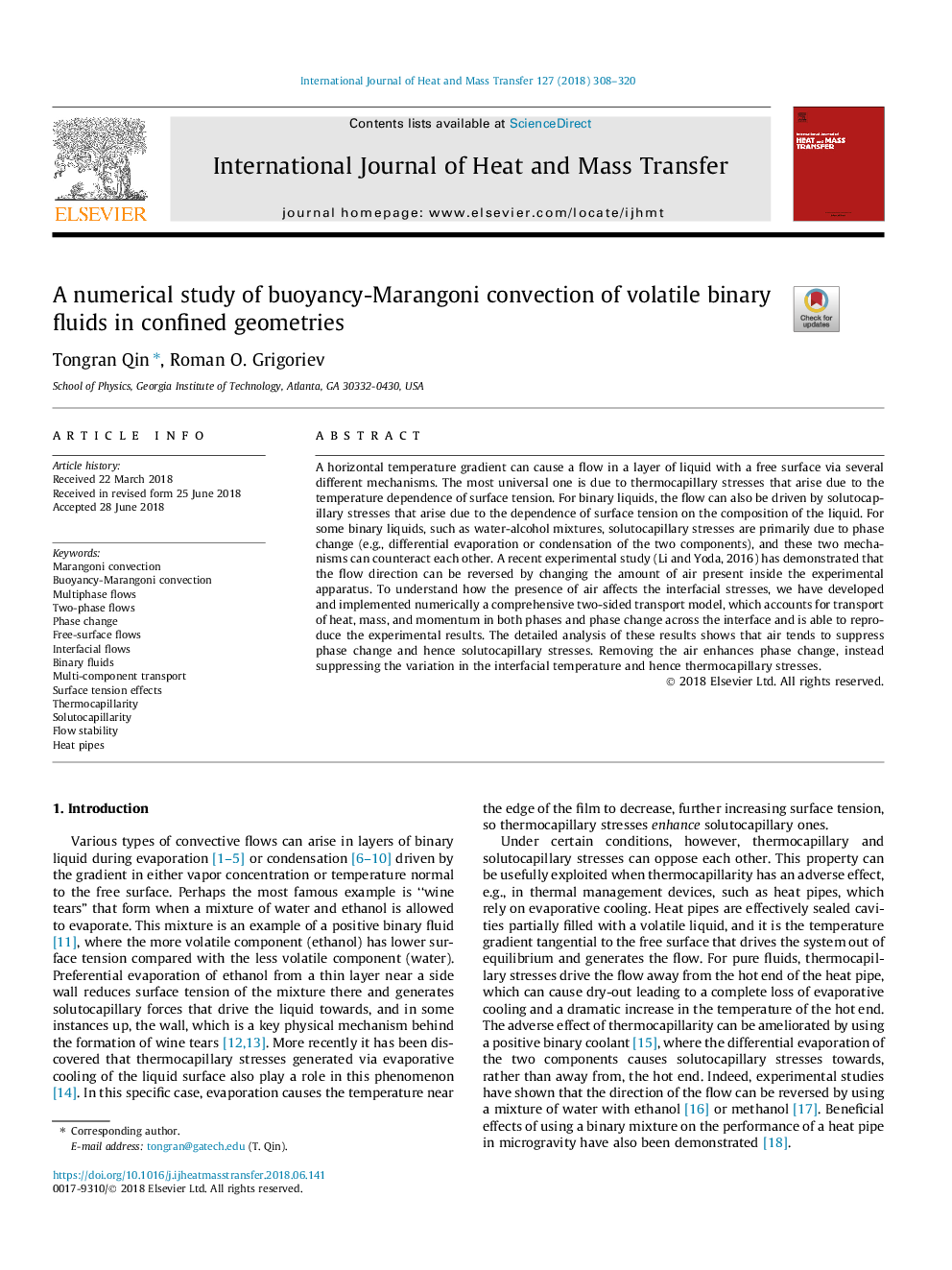| کد مقاله | کد نشریه | سال انتشار | مقاله انگلیسی | نسخه تمام متن |
|---|---|---|---|---|
| 7053674 | 1458011 | 2018 | 13 صفحه PDF | دانلود رایگان |
عنوان انگلیسی مقاله ISI
A numerical study of buoyancy-Marangoni convection of volatile binary fluids in confined geometries
ترجمه فارسی عنوان
مطالعات عددی از جابجایی شناورانس-مارنگونی از مایعات بیتی فرار در هندسه محدود
دانلود مقاله + سفارش ترجمه
دانلود مقاله ISI انگلیسی
رایگان برای ایرانیان
کلمات کلیدی
ThermocapillarityPhase change - تغییر فازFlow stability - ثبات جریانfree-surface flows - جریان آزاد آزادTwo-phase flows - جریان دو فازInterfacial flows - جریان های متقاطعMulti-component transport - حمل و نقل چند جزءHeat pipes - لوله های گرماBinary fluids - مایعات دودوییMultiphase flows - چند فاز جریان داردMarangoni convection - کنسانتره مارنگونی
ترجمه چکیده
گرادیان درجه حرارت افقی می تواند جریان را در یک لایه مایع با یک سطح آزاد از طریق مکانیزم های مختلف ایجاد کند. یکی از مهمترین وظایف این است که به دلیل تنش های ترموکاپیلی به دلیل وابستگی دمای تنش سطحی به وجود می آید. برای مایعات دودویی، جریان نیز می تواند توسط تنش های حلقه ای ایجاد شود که به دلیل وابستگی تنش سطحی به ترکیب مایع بوجود می آید. برای بعضی از مایعات دودویی مانند مخلوط آب و الکل، تنش های حلقوی مخزن عمدتا به دلیل تغییر فاز است (به عنوان مثال، تبخیر دیفرانسیل یا تراکم دو جزء) و این دو مکانیسم می توانند به یکدیگر متضرر شوند. یک مطالعه تجربی اخیر (لی و یودا، 2016) نشان داده است که با تغییر مقدار هوا موجود در دستگاه تجربی، مسیر جریان را می توان تغییر داد. برای درک چگونگی حضور هوا بر تنش های میان فاز، ما یک الگوی جامع دو طرفه حمل و نقل را برای انتقال حرارت، جرم و حرکت در هر دو مرحله و تغییر فاز در سطح رابط طراحی کرده ایم و قادر به نتایج تجربی را بازتولید کنید. تجزیه و تحلیل دقیق این نتایج نشان می دهد که هوا منجر به سرکوب تغییرات فاز و به همین ترتیب تنش های حلقه ای می شود. از بین بردن هوا، تغییر فاز را افزایش می دهد، در عوض سرکوب تغییرات در دمای بین فاز و به همین ترتیب تنش های ترموکاپیلی.
موضوعات مرتبط
مهندسی و علوم پایه
مهندسی شیمی
جریان سیال و فرایندهای انتقال
چکیده انگلیسی
A horizontal temperature gradient can cause a flow in a layer of liquid with a free surface via several different mechanisms. The most universal one is due to thermocapillary stresses that arise due to the temperature dependence of surface tension. For binary liquids, the flow can also be driven by solutocapillary stresses that arise due to the dependence of surface tension on the composition of the liquid. For some binary liquids, such as water-alcohol mixtures, solutocapillary stresses are primarily due to phase change (e.g., differential evaporation or condensation of the two components), and these two mechanisms can counteract each other. A recent experimental study (Li and Yoda, 2016) has demonstrated that the flow direction can be reversed by changing the amount of air present inside the experimental apparatus. To understand how the presence of air affects the interfacial stresses, we have developed and implemented numerically a comprehensive two-sided transport model, which accounts for transport of heat, mass, and momentum in both phases and phase change across the interface and is able to reproduce the experimental results. The detailed analysis of these results shows that air tends to suppress phase change and hence solutocapillary stresses. Removing the air enhances phase change, instead suppressing the variation in the interfacial temperature and hence thermocapillary stresses.
ناشر
Database: Elsevier - ScienceDirect (ساینس دایرکت)
Journal: International Journal of Heat and Mass Transfer - Volume 127, Part B, December 2018, Pages 308-320
Journal: International Journal of Heat and Mass Transfer - Volume 127, Part B, December 2018, Pages 308-320
نویسندگان
Tongran Qin, Roman O. Grigoriev,
